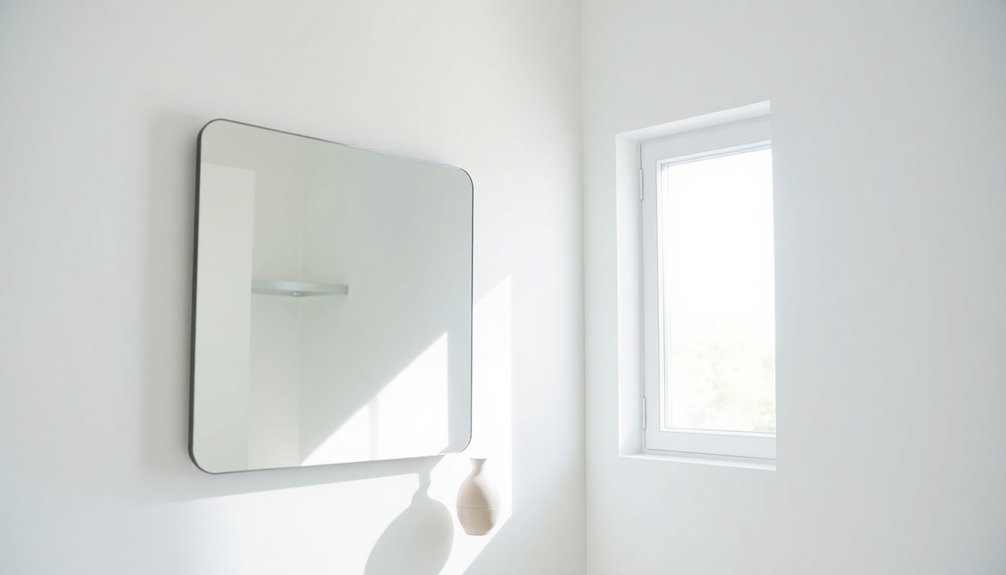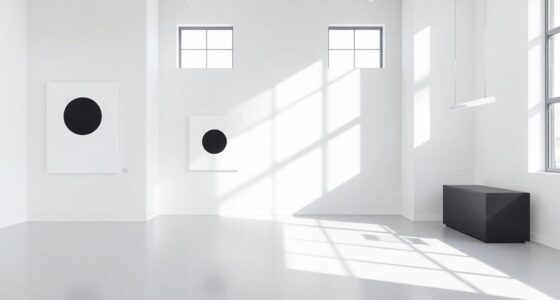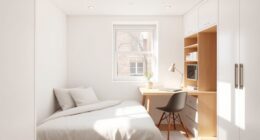To make small spaces feel bigger, opt for minimalist mirrors with clean lines and oversized designs. Hang them at eye level and position them across from windows to reflect natural light, amplifying brightness. Full-length mirrors in corners create height, while simple frames keep the focus on the illusion of openness. Strategic placements in shifting areas enhance flow. By incorporating these tips, you can transform your space into an inviting haven that feels much larger than it is. There's more to explore!
Key Takeaways
- Choose oversized mirrors with minimalistic frames to enhance the illusion of space without overwhelming the area.
- Hang mirrors at eye level (around 60 inches) to create a cohesive and spacious feel.
- Position mirrors across from windows to amplify natural light and brighten small spaces.
- Use vertical mirrors to create a sense of height, making the room feel larger.
- Incorporate mirrored furniture to enhance light flow, contributing to a seamless, expansive atmosphere.
The Impact of Mirrors on Room Perception
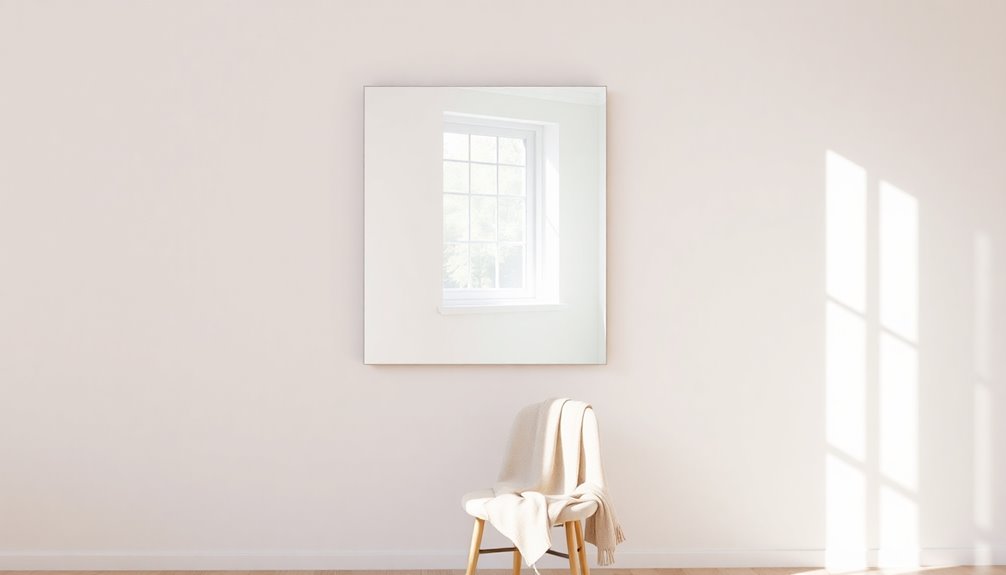
When you incorporate mirrors into your space, you'll notice how they can dramatically alter the room's perception.
Mirrors reflect light, greatly enhancing brightness and creating an illusion of space that makes a room feel larger and more inviting. By strategically placing large mirrors across from windows or light sources, you capture and amplify both natural and artificial light, further expanding the sense of openness.
A large mirror in a minimalist design can break up visual clutter, streamlining your decor for a less cramped vibe. Installing mirrors at eye level or higher adds the perception of taller ceilings, enhancing the overall height and spaciousness.
Incorporating mirrors not only serves a functional purpose but also adds depth and visual interest to your room. Additionally, the use of natural elements in your decor can complement the reflective surfaces, promoting a serene atmosphere.
Reflecting Light to Brighten Spaces
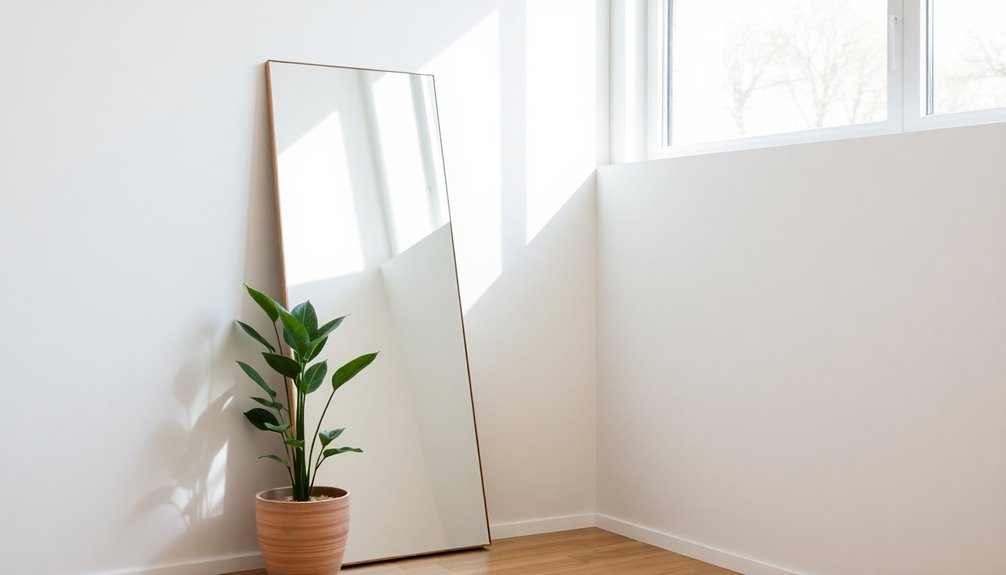
Mirrors act as powerful allies in brightening up your space. By reflecting light, they can transform small spaces into inviting havens.
Position a mirror directly across from a window to capture and amplify natural light, making a room feel more open. Strategic placement near light fixtures or lamps allows mirrors to spread illumination throughout dim corners, effectively brightening small spaces.
Positioning a mirror across from a window amplifies natural light, creating a more open and inviting atmosphere in any room.
Opt for a large mirror to maximize light reflection without overwhelming the area, creating an airy atmosphere that enhances the illusion of depth. Not only do mirrors serve as functional decor, but they also enhance light flow, turning your cozy nook into a lighter, larger environment.
Embrace mirrors to elevate your space!
Choosing the Right Mirror Size and Design
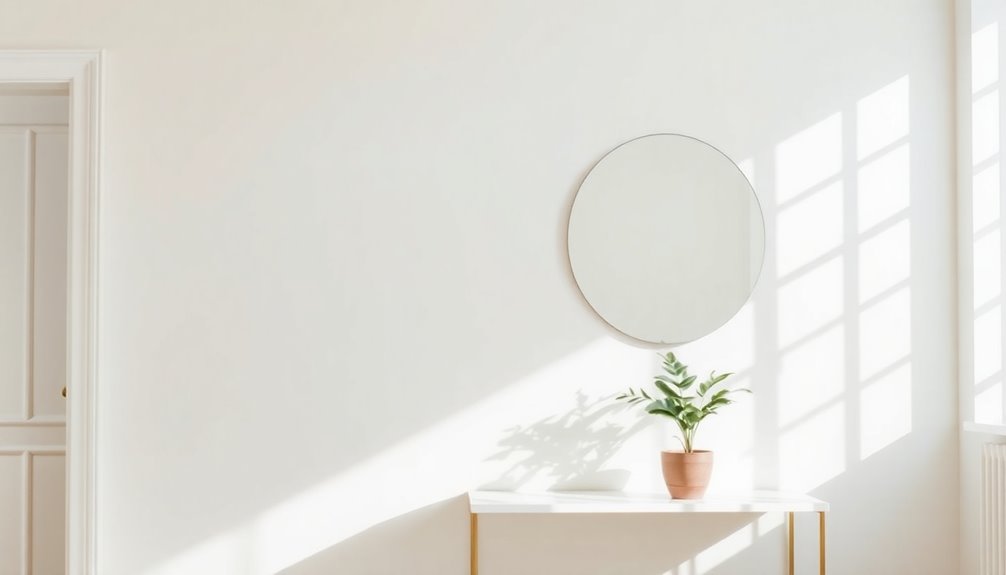
When choosing a mirror, opt for large pieces with minimalist frames to enhance your space without distraction.
Think about vertical mirrors to create height in smaller rooms, or horizontal ones for a wider look.
Emphasize Large Mirrors
Choosing the right size and design for large mirrors can dramatically transform a space. Opt for oversized mirrors with minimalistic frames to enhance the illusion of more space in compact areas.
Vertical mirrors draw the eye upward, making ceilings feel higher, while horizontal mirrors widen the perception of your room. A large mirror that reflects natural light from windows brightens the environment, creating a seamless connection with the outdoors and making it feel more spacious.
Incorporating full-length mirrors in corners maximizes reflective surface area, amplifying light and depth. Keep the designs simple and unobtrusive to guarantee the focus remains on the optical illusion of space rather than the frame itself. Additionally, consider the importance of functionality in your design choices to ensure that the mirror complements the overall aesthetic and utility of the space.
Minimalist Frame Options
Large mirrors with minimalistic frames have a profound impact on how a space feels, but the right frame can elevate that effect even further.
Opt for oversized mirrors that reflect light and enhance brightness, especially in smaller, darker areas. Minimalist frames, with their simple designs, prevent distraction and keep the focus on the mirror's effect.
If you want to create an illusion of height, vertical mirrors are your best bet, while horizontal mirrors can help expand perceived width.
Remember to hang your mirrors at eye level, around 60 inches, to maintain a cohesive look. This approach not only enhances spaciousness but also makes your room feel more inviting and open. Additionally, incorporating neutral color palettes in your decor can further enhance the airy atmosphere created by mirrors.
Consider Vertical vs. Horizontal
While considering the size and design of your mirror, it's essential to think about the orientation that best suits your space.
Vertical mirrors create an illusion of height, making ceilings appear taller, which is perfect for compact areas with low ceilings. On the other hand, horizontal mirrors provide the impression of width, making narrow spaces feel more expansive, especially in hallways or small living rooms.
Oversized mirrors, regardless of their orientation, maximize light reflection, brightening the atmosphere. Opting for minimalist designs, like simple frames or frameless options, helps maintain a clean aesthetic while enhancing the room's perceived size.
Ultimately, choosing the right size and orientation can greatly alter your room's dynamics, drawing the eye upward or broadening the visual field.
Strategic Mirror Placement Tips
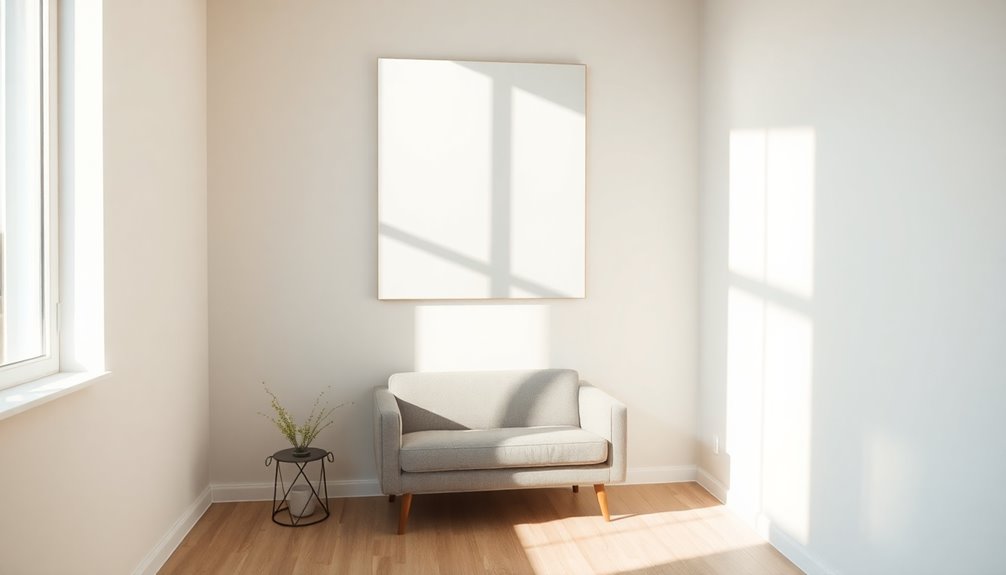
When it comes to placing mirrors strategically, think about where you hang them and the angles they create.
Hanging mirrors at eye level can help unify your space, while positioning them across from windows boosts natural light.
Pairing mirrors with light sources amplifies brightness, making your room feel larger and more inviting.
Eye-Level Hanging Techniques
Hanging mirrors at eye level, typically around 60 inches from the floor, is essential for creating a cohesive and spacious feel in your room.
By maintaining a consistent hanging height for both mirrors and artwork, you enhance visual continuity, avoiding a cluttered look. Leave at least a 2-inch border between the mirror and adjacent walls or ceilings to maximize the illusion of height.
In small spaces, consider tall or full-length mirrors in corners; they draw the eye upward and reflect light from multiple angles.
Position mirrors opposite windows or light sources to capture and amplify natural light, further enhancing the sense of openness and making your space feel larger and more inviting. Additionally, enhancing air quality with effective reduction of allergens can further contribute to a more pleasant and spacious atmosphere in your home.
Reflective Angles for Expansion
To create a sense of expansion in your space, strategically placing mirrors can make a significant difference.
Position mirrors across from windows to reflect natural light, enhancing the feeling of spaciousness in small rooms. Use tall or full-length mirrors in corners to draw the eye upward, creating an illusion of height that makes the room feel larger.
Hang mirrors at eye level, around 60 inches, to maintain visual continuity and optimize your perception of space. Incorporate mirrored furniture, like coffee tables, to reflect light and contribute to an expansive feel.
Additionally, place mirrors in transitional zones or opposite doorways to elongate sightlines, enhancing the overall spatial perception and flow between spaces. Adding natural materials to your decor can further enhance the ambiance and contribute to a sense of openness.
Light Source Pairing Strategies
Maximizing light in your space can be achieved through thoughtful mirror placement.
Employ these light source pairing strategies to optimize light reflection and create a brighter atmosphere:
- Position mirrors near lamps or windows to reflect light around the room.
- Hang mirrors at eye level (about 60 inches) for the best light reflection and to enhance room height.
- Place mirrors opposite light fixtures to balance illumination and eliminate shadows.
- Incorporating mirrors can also reduce stress levels, promoting a sense of calm in your environment.
Creating Optical Illusions With Mirrors
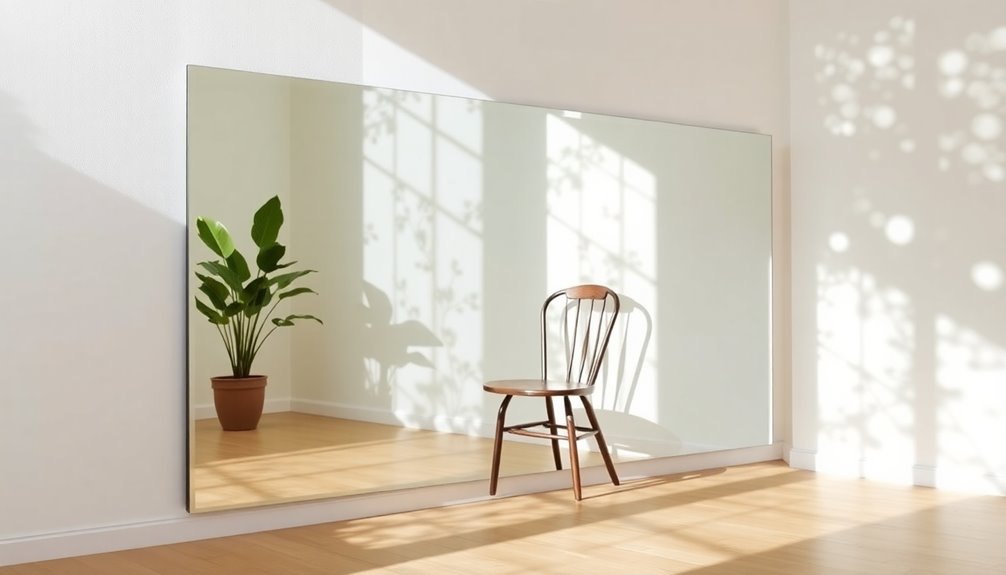
When you strategically place mirrors in your space, you can create stunning optical illusions that enhance both light and perceived size.
For instance, placing large mirrors directly across from windows allows them to reflect outdoor views, making your small spaces feel larger.
Using tall or full-length mirrors in corners reflects light from various angles and draws the eye upward, boosting the sense of height.
Grouping smaller mirrors in a gallery wall style adds movement and interest while keeping the design airy.
Hang mirrors at average eye level, around 60 inches, to maximize reflections and enhance the illusion of space.
Additionally, consider mirrored furniture to further elevate light flow and create a seamless, expansive atmosphere. Moreover, incorporating wide color gamut in your decor can also enhance the visual experience, much like how it improves projection quality in home cinema setups.
Incorporating Mirrors Into Your Decor
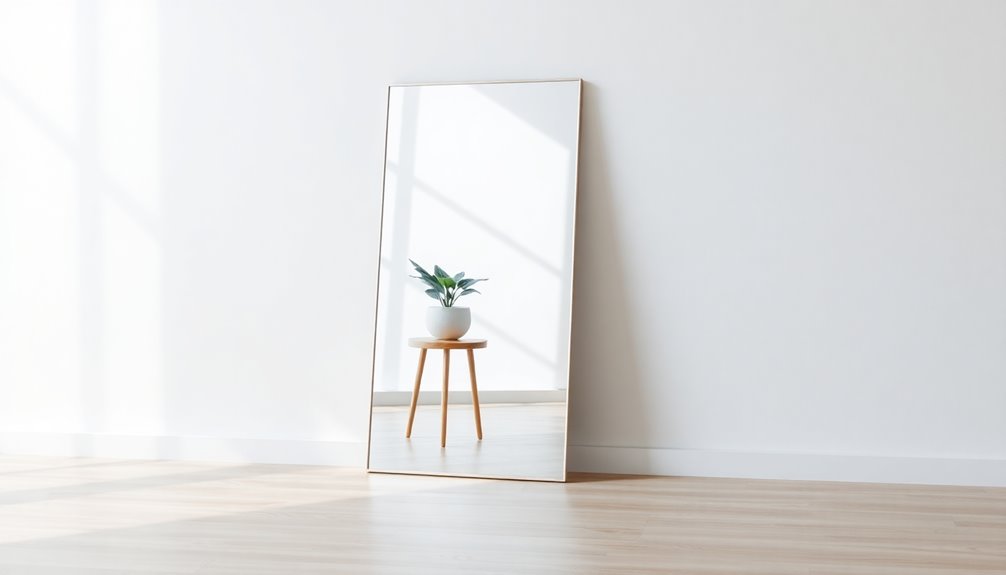
Incorporating mirrors into your decor can transform your space, making it feel brighter and more expansive. When you add mirrors, you can create the illusion of depth in small spaces.
Here are some tips to enhance your decor with minimalist mirrors:
- Place mirrors near light sources to amplify brightness.
- Use floor mirrors in dark corners to brighten and expand your area.
- Hang mirrors at eye level to reflect important elements and enhance spatial perception.
When mirrors are placed strategically, they reflect light and make your room feel larger and brighter. Consider setting realistic goals to guide your decor choices, ensuring each mirror serves a purpose and adds to the overall aesthetic.
Consider grouping small mirrors in a gallery wall style to add depth without clutter. By thoughtfully adding mirrors, you can elevate both the aesthetics and the functionality of your space.
Using Mirrors in Transitional Areas
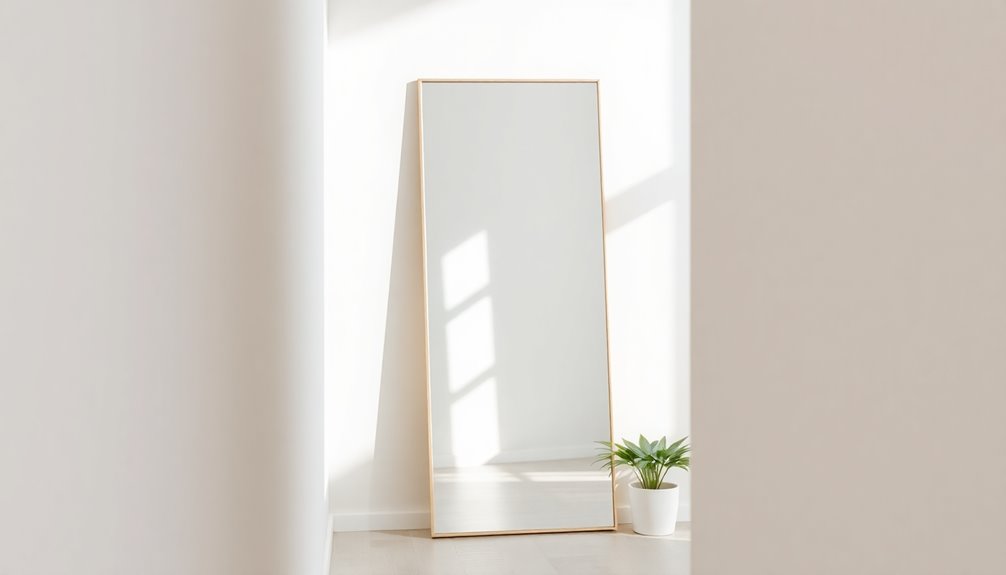
Using mirrors in shifting areas can greatly enhance the flow of your home. Position mirrors in evolving areas like hallways or near entrances to elongate the eye-line and create a sense of continuity between rooms.
Hang mirrors opposite doorways; this effectively masks boundaries, making spaces feel more open and interconnected.
Positioning mirrors across doorways creates an illusion of openness, seamlessly connecting different areas of your home.
Strategically placed mirrors can reflect light from windows or fixtures, increasing brightness and enhancing the perception of spaciousness in narrow passages.
Choose minimalist mirror designs that blend seamlessly with your decor, ensuring they enhance rather than overwhelm these areas.
Maximizing Light With Reflective Surfaces
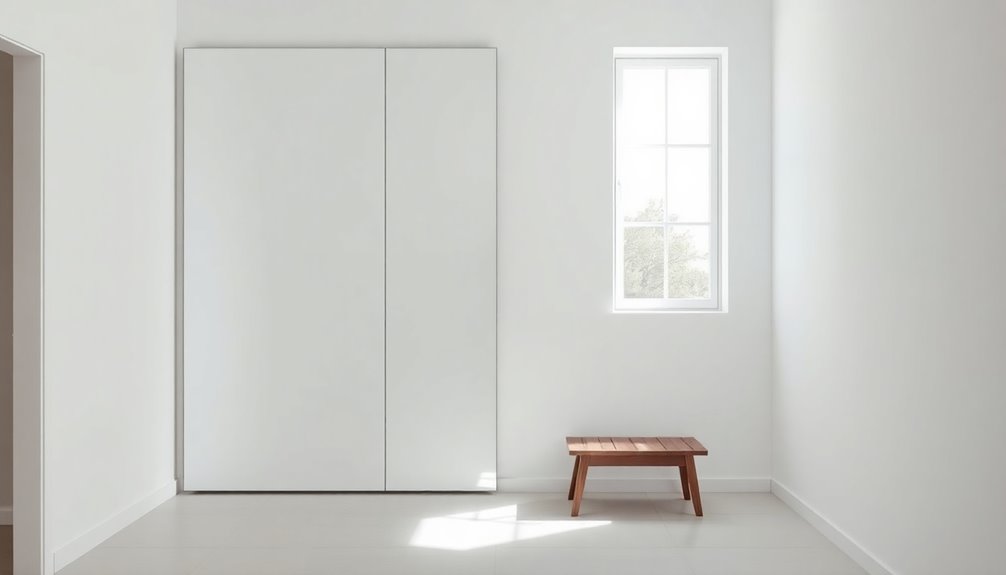
To maximize light in your space, position mirrors across from windows to reflect natural sunlight effectively. You'll brighten small areas and create an illusion of openness. Incorporating minimalist designs guarantees the mirrors enhance brightness without overwhelming your decor. Additionally, using energy-efficient models can help maintain a sustainable approach to lighting in your home.
Reflect Natural Light Effectively
When you position mirrors directly across from windows, you can greatly enhance the flow of natural light in your space. This simple trick brightens small spaces and creates an inviting atmosphere.
Here are some effective strategies:
- Use large, minimalist mirror designs to reflect more light and enhance the illusion of space.
- Place mirrors near light fixtures to amplify both natural and artificial light.
- Opt for vertical mirrors to create a sense of height, further maximizing light reflection.
Incorporating mindful purchasing of reflective surfaces can also contribute to a more sustainable and aesthetically pleasing environment.
Enhance Brightness in Rooms
Maximizing light in your rooms can transform the atmosphere, making spaces feel larger and more inviting.
To enhance brightness in small spaces, position mirrors directly across from windows to reflect natural light throughout the room. Opt for large, minimalist designs that won't overwhelm your decor while effectively capturing and amplifying light.
Place mirrors near light fixtures or lamps to amplify artificial light, creating a warm and welcoming vibe. Tall or full-length mirrors, when strategically placed in corners, can reflect light from multiple angles, brightening shadowy areas.
Remember to avoid excessive mirrors to maintain comfort; focus on strategic placements that facilitate light flow and elevate the overall ambiance of your space.
Mirrored Furniture for Space Expansion
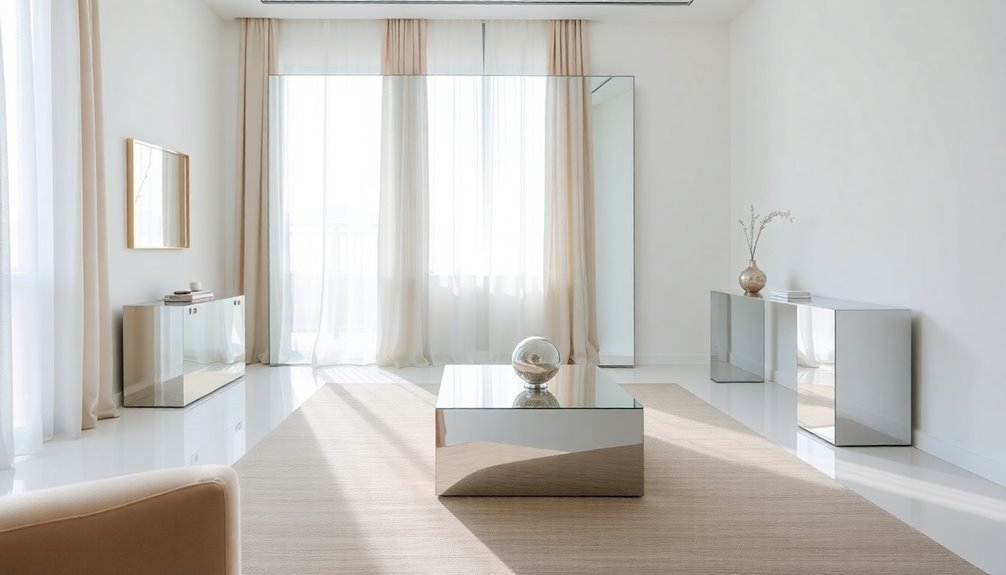
Mirrored furniture offers a clever way to enhance the perception of space in smaller rooms. By incorporating these stylish pieces, you can achieve a remarkable space expansion effect.
Consider the following benefits:
- Reflective Effect: Mirrored surfaces bounce light around, brightening small spaces.
- Illusion of More Space: Items like mirrored storage consoles reflect the surrounding area, making your room feel larger.
- Minimalist Styles: Opting for sleek designs helps maintain an airy aesthetic while maximizing functionality.
Using mirrored furniture not only breaks up visual clutter but also adds elegance to your decor.
Strategically placing these pieces in corners or against walls can enhance their space-expanding effect, making every nook feel more organized and inviting.
Enhancing Outdoor Spaces With Mirrors
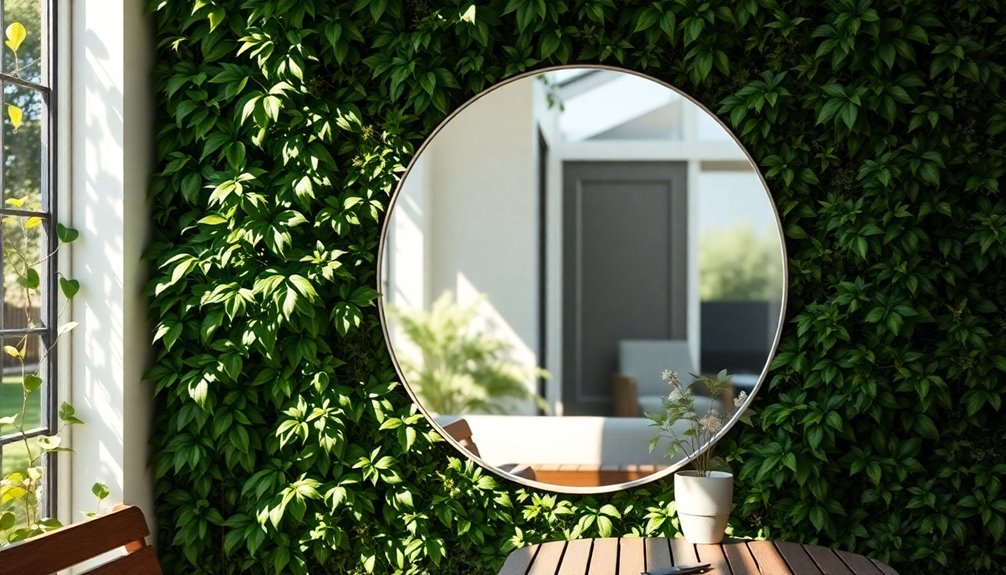
Adding mirrors to your outdoor spaces can transform them into inviting retreats that feel more expansive and connected to nature.
Leaning large mirrors on patios or balconies creates the illusion of a larger area and adds visual depth, making your outdoor setting more appealing.
Leaning large mirrors on patios enhances visual depth, creating an illusion of spaciousness that elevates your outdoor ambiance.
Choose rustic mirrors designed to withstand the elements, ensuring durability while enhancing your outdoor aesthetics.
Position mirrors to reflect stunning garden views or surrounding greenery, seamlessly bringing nature into your living space.
You can also incorporate mirrored furniture, like coffee tables, to maximize light flow and enhance the spacious feel.
Strategic mirror placement amplifies sunlight exposure, creating an inviting atmosphere that encourages relaxation and enjoyment in your outdoor oasis.
Frequently Asked Questions
How to Use Mirrors to Make a Small Room Look Bigger?
To make a small room look bigger, position large mirrors across from windows to reflect natural light and views.
Opt for vertical or oversized mirrors to enhance height perception without overwhelming the space.
Hang them at eye level, around 60 inches, for a cohesive feel.
Use floor mirrors in dark corners to brighten those areas and create a sense of depth.
Incorporate mirrors near light sources to amplify brightness and improve the overall ambiance.
How Do Designers Make a Small Space Appear Bigger?
Imagine stepping into a cozy coffee shop where the walls gleam with reflective surfaces.
Designers make a small space appear bigger by strategically using light and reflection. They hang mirrors at eye level, drawing your gaze upward, and position them opposite windows to bounce natural light around.
Incorporating mirrored furniture adds depth, while arranging smaller mirrors in a gallery wall style creates visual interest and enhances the overall perception of openness in the room.
Why Do Mirrors Make a Room Feel Bigger?
Mirrors make a room feel bigger because they reflect light and create depth. When you place a mirror opposite a window, it captures natural light, brightening the space. This illusion of openness can trick your mind into thinking the room is larger.
Additionally, hanging mirrors at eye level or higher draws your gaze upward, giving the perception of taller ceilings. Overall, mirrors enhance brightness and spaciousness, making any room feel more airy and inviting.
Are Mirrors Good for Small Spaces?
Yes, mirrors are great for small spaces! They reflect light and create an illusion of depth, making your room feel larger and brighter.
When you hang a large mirror at eye level, it draws the eye upward, enhancing vertical space.
Positioning mirrors across from windows maximizes natural light, while mirrored furniture adds depth without overwhelming your design.
Conclusion
In small spaces, mirrors can transform the ordinary into the extraordinary. They reflect light, creating an illusion of expansiveness, yet they also offer a sense of intimacy by drawing you in. By choosing the right designs and placements, you'll blur the lines between space and depth, making your home feel both larger and cozier. So, embrace the power of mirrors—they're not just decorative; they're a bridge between confinement and freedom in your living environment.
